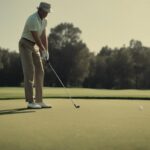- 7 Top Flite Golf Clubs XL for Improved Performance - September 28, 2024
- Top Flite Golf Clubs: Top 5 Reasons to Choose Them - September 28, 2024
- Top 3 Golf Club Fitters for a Perfect Swing - September 28, 2024
As a beginner, you start with a solid foundation in golf by ensuring your club face is properly aligned, as even a slight misalignment can drastically alter your shot's trajectory and accuracy. To achieve this, focus on proper alignment fundamentals, including parallel feet, hips, and shoulders to the target line, and a square club face at setup. Regular practice with alignment aids and drills will help you develop muscle memory and a consistent pre-shot routine. By mastering club face position and alignment, you'll be on your way to improving your shot accuracy and overall game – and there's more to explore to take your skills to the next level.
Key Takeaways
- Ensure the golf club face is square to the target line at setup for initial direction and accurate shots.
- Maintain parallel alignment of feet, hips, and shoulders to the target line for a consistent swing path.
- A neutral grip helps achieve a square club face at impact, reducing chances of slicing or hooking the ball.
- Regular practice with alignment aids, such as sticks, reinforces habit of checking club face position and body positioning.
Mastering Golf Alignment Fundamentals
To establish a consistent and accurate swing, start by mastering the fundamental principle of proper alignment, as it lays the foundation for a precise shot direction and overall golfing success.
When you're on the golf course, it's vital to position your feet, hips, and shoulders parallel to the target line, ensuring a smooth swing path and accurate shots. Make sure the clubface is square to the target line at setup, and focus on returning it to a square position at impact. Visualization techniques can also help you stay aligned – try selecting an intermediary target to enhance your aiming accuracy.
To reinforce proper alignment, incorporate alignment drills into your practice routine. Using alignment sticks or other tools can help you develop muscle memory and improve your overall performance.
Be aware of common misalignment issues, such as an inconsistent grip or improper stance width, and make adjustments accordingly. By mastering these fundamental principles, you'll be well on your way to a more consistent and accurate golf swing.
Techniques for Improving Aiming
Frequently, golfers struggle with aiming, but by incorporating a few simple techniques into your pre-shot routine, you can greatly enhance your accuracy and consistency off the tee.
First, make sure your golf club face is square to the target line at setup, as this determines the initial direction of the ball at impact. Visualize an intermediary target, such as a spot a few feet in front of the ball, to guide your aim and reinforce focus on the desired line.
Keep your feet, hips, and shoulders parallel to the target line during your stance, enhancing overall alignment and accuracy. Regularly practice with alignment aids, like alignment sticks or markers on the ground, to establish a consistent aiming routine.
Develop a pre-shot routine that includes checking clubface alignment and body positioning to considerably improve your overall aiming accuracy. By implementing these techniques, you'll be able to hit more accurate golf shots and take your game to the next level.
Choosing the Right Golf Clubs
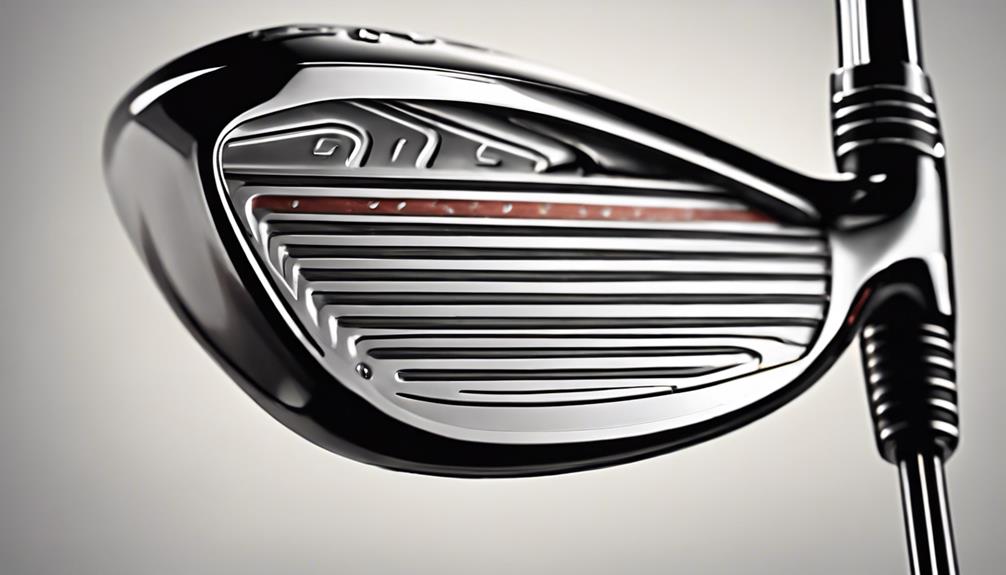
When you're selecting golf clubs, your first consideration should be your own unique characteristics, including your skill level, height, and arm length, as these factors play a significant role in determining the ideal club length and type for your game. As a beginner, you'll want to prioritize forgiveness and accuracy, which is why cavity back irons are a great choice. They offer a larger sweet spot, making it easier to achieve consistent shots.
| Club Type | Best For |
|---|---|
| Drivers | Tee shots, maximum distance |
| Hybrids | Long shots, replacing long irons |
| Wedges | High-arcing shots, bunker shots, and chipping |
When choosing your clubs, consider the materials used in their construction. Graphite shafts are lighter and help generate more clubhead speed, making them ideal for many beginners. Steel shafts, on the other hand, offer more control and feedback. It's crucial to get fitted by a professional if possible to guarantee the lie angle of your clubs matches your stance and swing. With the right clubs, you'll be able to practice every day and improve your game. Remember, the right clubs can help you hit better shots, even with Golf Balls that aren't perfectly aligned.
Understanding Ball Flight Dynamics
You'll soon discover that the position of the clubface at impact is the primary factor influencing the ball's initial direction, making it an important aspect to master if you want to achieve consistent shots.
As a beginner, understanding ball flight dynamics is vital to improving your game. The clubface's position determines the ball's direction, with a square face resulting in straight shots and an open or closed face leading to slices or hooks, respectively.
Your swing path also plays a significant role, as an outside-to-inside path combined with an open clubface can exacerbate slicing tendencies. By grasping the relationship between clubface position and swing path, you can diagnose and correct alignment issues that lead to undesirable ball flight.
To improve your accuracy, focus on achieving a square clubface at impact and a consistent swing path. This will help you develop a more predictable shot trajectory and reduce shot dispersion.
With practice and patience, you'll be able to refine your swing mechanics and reveal a more consistent ball flight, taking your game to the next level.
The Importance of Club Face Position
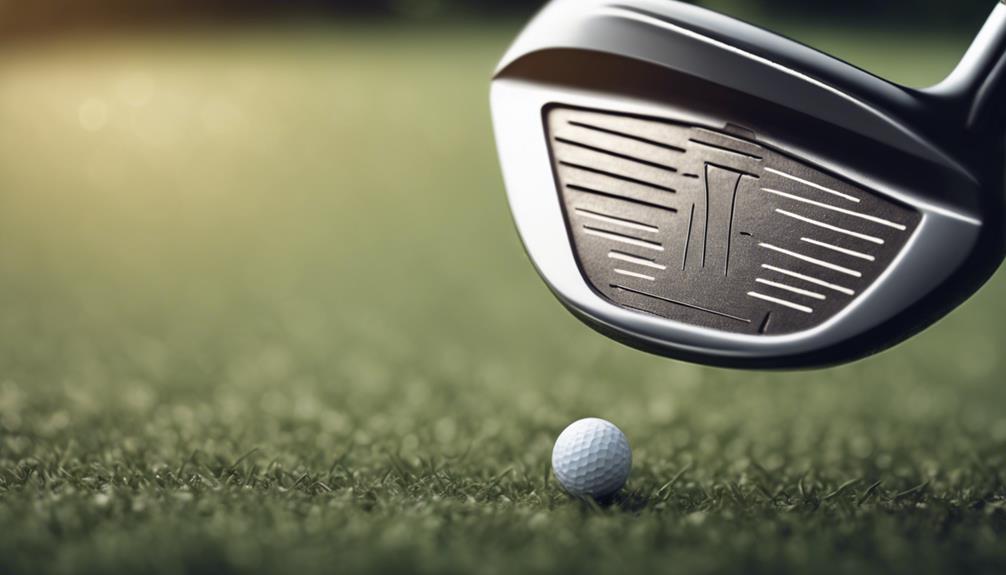
Mastering the club face position is vital to releasing consistent shots, as even slight deviations from a square face can dramatically alter the ball's trajectory. You need to understand that the club face position at impact determines the initial direction of the ball, so it's important to get it right.
As a beginner, it's significant to focus on proper alignment of the club face at setup, making sure it's square to the target line. This helps guarantee consistent shot accuracy and reduces the likelihood of misalignment.
You'll find that maintaining a neutral grip can help you achieve a square club face at impact, enhancing shot consistency. Regular practice with alignment aids, such as alignment sticks, can reinforce the habit of checking club face position during setup and throughout the swing.
Remember, club face control is key to precise shot accuracy. By mastering the impact position, you'll be able to hit shots with confidence, knowing that your club face is square to the target.
With consistent practice, you'll develop the skills to hit accurate shots time and time again.
Avoiding Slices and Hooks
As you work on avoiding slices and hooks, you'll need to focus on two critical factors: club face alignment and proper grip practices.
You'll want to guarantee your club face is square at setup and impact, and that your grip isn't contributing to misalignment.
Club Face Alignment
Proper alignment of the club face at impact is critical, and even a slight deviation can result in a slice or a hook. This makes it essential to develop a consistent pre-shot routine to guarantee a square club face.
To achieve this, you'll need to make clubface adjustments to ensure it's aligned with your target line. Practice alignment drills with tools like alignment sticks to reinforce proper clubface orientation.
Additionally, target visualization is key—visualize the desired shot trajectory before addressing the ball to enhance your focus on proper clubface alignment. This will help you maintain a consistent swing and return the clubface square to the target at impact.
Regularly review and adjust your stance and body alignment, keeping your feet, hips, and shoulders parallel to the target line. This will greatly improve clubface alignment and reduce the occurrence of hooks and slices.
Proper Grip Practices
You'll find that a consistent grip is just as essential as proper club face alignment. By developing good grip habits, you can further reduce your chances of slicing or hooking the ball.
A neutral grip, where the 'V' formed by your thumb and index finger points towards your right shoulder, helps maintain a square clubface at impact. Confirm your grip pressure is relaxed, not too tight, to allow for better clubface control.
Avoid an overly strong grip, which can lead to hooks, or an overly weak grip, which can cause slices. To develop a consistent grip, practice grip adjustments and use alignment aids.
Visualize the desired shot shape while gripping the club to enhance your awareness of how grip influences clubface position. By doing so, you'll become more mindful of your grip's impact on ball flight, reducing unwanted slices and hooks.
Mental Strategies for Golf Success
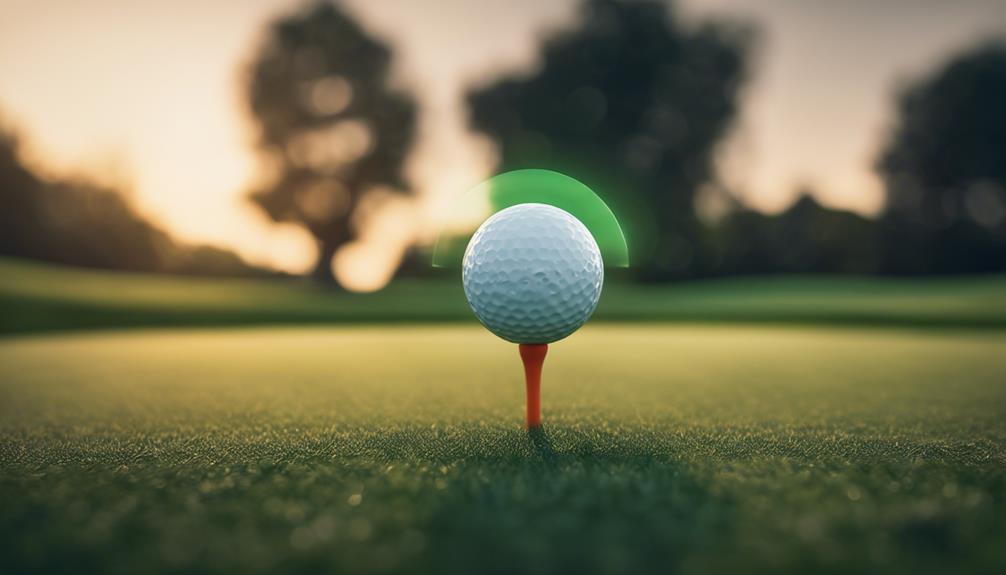
Developing a strong mental game is vital to revealing your full golfing potential, and it starts with mastering a range of effective mental strategies. One key technique to focus on is visualization.
By picturing the desired ball flight, you can considerably enhance your alignment and aiming accuracy, leading to better shot execution. Establishing a consistent pre-shot routine, which may include visualization, stance setup, and practice swings, also helps to reinforce your focus and mental preparedness before each shot.
Mental resilience is equally important in golf, as it allows you to maintain composure and confidence throughout your round, even when faced with challenges or mistakes. To cultivate this resilience, incorporate relaxation strategies into your game, such as deep breathing or positive affirmations.
These techniques can help reduce anxiety and improve your concentration during gameplay. By regularly practicing these mental strategies alongside your physical skills, you'll foster a well-rounded approach to improvement, ultimately leading to lower scores and greater enjoyment on the course.
Identifying Common Alignment Errors
As you set up for your shot, it's crucial to identify and correct common alignment errors that can throw off your game.
You'll want to pay attention to your body position, making sure you're not misaligned, as well as the angle of your clubface, which can be open or closed.
Additionally, you'll need to assess your grip, as inconsistent pressure can cause the clubface to tilt at impact, leading to mishits.
Misaligned Body Position
When addressing misaligned body position, one of the most vital aspects to examine is the parallel alignment of your feet, hips, and shoulders to the target line, as even slight deviations can greatly impact shot accuracy.
Achieving proper body balance is essential, and it starts with your stance width. If your stance is too wide or too narrow, it can destabilize your swing and negatively impact alignment during the shot.
Here are some common errors to watch out for:
- Failing to maintain parallel alignment of feet, hips, and shoulders to the target line
- Neglecting the importance of hand position, resulting in an incorrect grip
- Failing to focus your eyes on the target line, leading to poor aiming and inconsistent shot direction
Clubface Angle Issues
You'll want to pay close attention to your clubface angle, since even slight misalignments can send your ball slicing or hooking off target.
A square clubface at impact is essential for straight shots, while an open or closed clubface can lead to wayward shots. If you're consistently hitting slices or hooks, it's likely due to a misaligned clubface.
As a right-handed golfer, a closed clubface can cause the ball to curve left, while an open clubface can cause it to curve right. To correct this, focus on making clubface adjustments to achieve angle consistency.
Regular practice with alignment aids, such as alignment sticks, can help you visualize and correct your clubface angle during setup.
Be aware of your clubface position during the backswing and follow-through, as these phases influence the final angle at impact. By making these adjustments, you'll start to see improved accuracy and more consistent shots.
Grip Problems
Grip problems can sneak up on even the most experienced golfers, causing misalignment and throwing off their entire game. As a beginner, it's crucial to identify and correct grip-related issues to achieve consistent alignment and shot direction.
Here are some common grip problems to watch out for:
- Inconsistent grip pressure: Uneven pressure can cause the clubface to rotate unpredictably during the swing, leading to alignment errors.
- Misaligned hands: Failure to position your hands correctly on the grip can prevent the clubface from returning square at impact, resulting in shots that veer off target.
- Weak or strong grip: A grip that's too weak or strong can lead to misalignment of the clubface at impact, resulting in unwanted ball flight patterns.
Regularly checking your grip alignment during practice can help you identify and correct these issues before they negatively impact your performance on the course.
Effective Practice Techniques
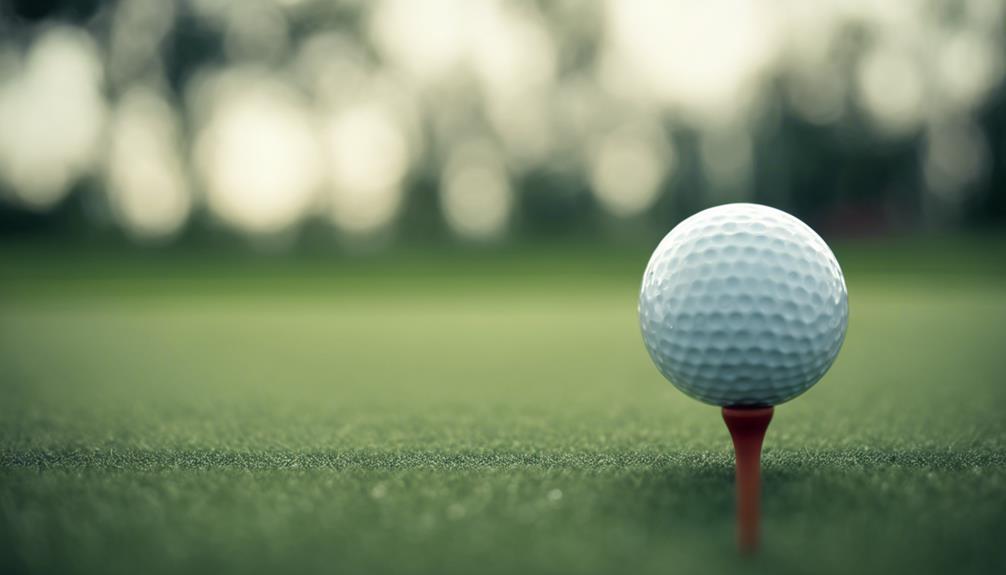
To develop a consistent and reliable swing, incorporate these effective practice techniques into your training routine to assure your golf club face is square and aligned at impact.
One effective drill is to use alignment sticks during practice to establish a clear target line and assure your clubface is square at setup, promoting consistent ball flight. You can also incorporate mirror drills to visually check your grip and clubface position, helping to reinforce proper alignment and awareness of your setup.
Another practice routine to try is the bucket drill, where you aim at a bucket placed 10-15 yards away to enhance your aiming accuracy and develop a feel for your clubface's alignment at impact. Regularly practicing straight shots with a square clubface will help build muscle memory essential for effective shot-making.
Additionally, engage in visualization techniques before each shot, picturing the desired ball flight and target, to improve mental focus on clubface alignment during practice sessions.
Where to Practice Your Golf Swing
As you start practicing your golf swing, it's important to find the right locations to hone your skills.
You'll want to contemplate practicing at home, where you can focus on perfecting your technique in a comfortable and convenient setting.
Alternatively, a driving range offers a more dynamic environment where you can test your skills with different clubs and receive instant feedback.
Practice at Home
By dedicating a section of your backyard or garage to golf practice, you can effectively hone your swing in a comfortable and convenient environment. This allows you to focus on your technique without distractions, perfecting your home practice routines.
Here are some essential indoor training tools and backyard drills to incorporate into your practice:
- Use alignment sticks to guarantee proper setup and targeting.
- Employ a full-length mirror to visually check your stance, grip, and clubface alignment.
- Utilize a golf simulator or swing analysis app to practice indoors while receiving data on swing speed, clubface angle, and ball flight trajectory.
Driving Range Benefits
You head to the driving range, a controlled environment where you can hone your golf swing without the pressure of an actual game. This setting allows you to focus on perfecting your technique.
Here, you can experiment with different clubs, understanding how each face affects ball flight and accuracy. Many driving ranges offer alignment aids, such as colored lines or target markers, to help you master proper alignment and aiming techniques.
As you practice, you'll develop a better feel for your clubface positioning, grip, stance, and swing mechanics. To get the most out of your session, remember to follow driving range etiquette, such as taking turns and keeping your voice down.
Structure your practice session by focusing on one aspect of your swing at a time, and don't be afraid to try out different equipment to find what works best for you.
Benefits of Better Alignment
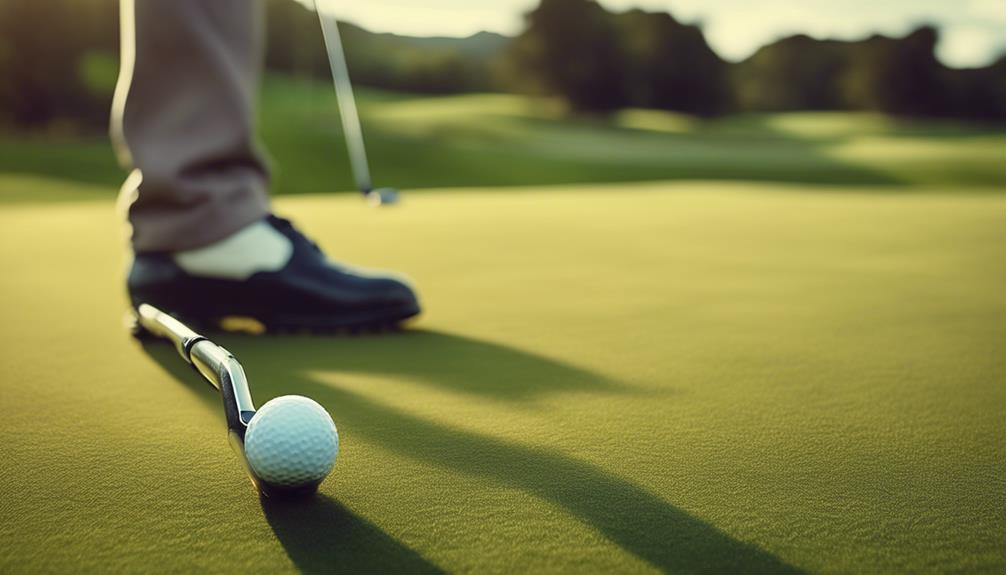
One of the most significant advantages of proper alignment is that it leads to more consistent contact with the ball, resulting in a higher likelihood of achieving the desired shot shape and distance.
As you focus on improving your alignment, you'll notice a significant reduction in slices and hooks, and a boost in confidence on the course.
Here are some key benefits you can expect from better alignment:
- Improved shot accuracy and consistency, thanks to a square clubface at impact.
- Enhanced confidence and reduced frustration, as you start hitting more predictable shots.
- Better scores, as you minimize errant shots and develop a more consistent game.
Continuous Improvement Strategies
To take your alignment to the next level, focus on implementing a set of continuous improvement strategies that reinforce proper clubface positioning and help you build a consistent pre-shot routine. Regular practice with alignment aids, such as sticks or visual markers, will help you develop muscle memory for correct clubface alignment. Engage in drills that focus on returning the clubface to a square position at impact, ensuring consistent shots.
Incorporate visual feedback tools, like mirrors or video analysis, to monitor and correct your clubface alignment during practice sessions. This creates a feedback loop, allowing you to adjust and refine your technique.
Set achievable goals for improving clubface control, and track your progress to maintain motivation and accountability. By doing so, you'll be able to identify areas for improvement and make adjustments accordingly.
Frequently Asked Questions
What Is the Proper Golf Setup Face On?
When you set up, guarantee the clubface is square to the target line, with a neutral grip and even grip pressure, while maintaining a shoulder-width stance and incorporating alignment tips for a consistent shot.
How Should a Beginner Hold a Golf Club?
'Remember the sweet spot? You'll find it with a neutral grip, placing the club in your fingers, not palms. Confirm hand placement is correct, with a light grip pressure and suitable wrist angle, and you'll be swinging like a pro!'
How Should My Club Face Be?
You should align your club face directly at the target, ensuring it's square to the target line at address, and maintain this impact position throughout your swing path to achieve a precise and consistent shot.
What Is the Correct Club Face Position at Address?
Imagine a precision-crafted puzzle piece – that's your club face at address. You're aiming to slot it perfectly, with the leading edge perpendicular to the target, ensuring a square club face alignment, ideal club face angle, and precise club face impact for a masterful shot.
Conclusion
As you refine your golf club face alignment, remember that small tweaks can add up to major improvements.
Think of it like fine-tuning a precision instrument – a slight adjustment can resonate throughout your entire game.
For instance, a study found that a mere 1-degree deviation in club face alignment can result in a 10-yard difference in ball flight.
By dialing in your alignment, you'll be amazed at how far your game can soar.




